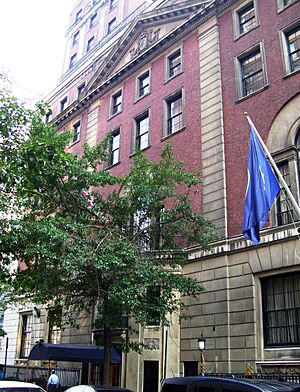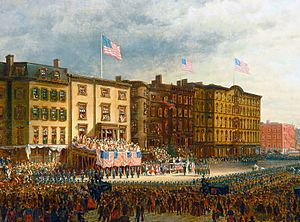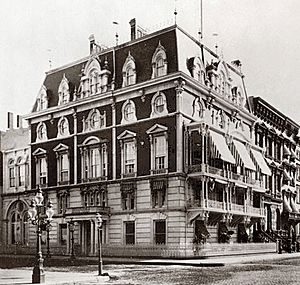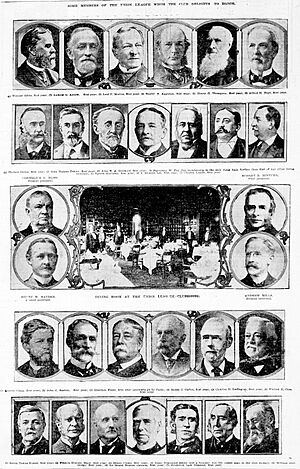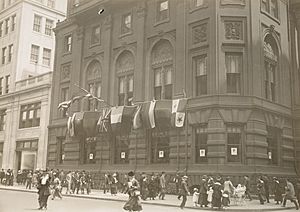Union League Club facts for kids
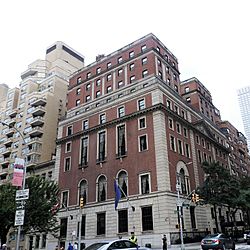
Exterior of the clubhouse in 2022
|
|
| Formation | 1863 |
|---|---|
| Type | Private social club |
| Location | |
| Affiliations | Union League |
| Website | unionleagueclub.org |
The Union League Club is a special private club in New York City. It started in 1863 and is connected to the Union League. Its current home, called a clubhouse, is at 38 East 37th Street and Park Avenue in the Murray Hill area of Manhattan.
Benjamin Wistar Morris designed the building, which opened on February 2, 1931. This building became a New York City landmark on October 25, 2011. It's known as one of the most important clubs in New York City. Other Union League clubs, which are separate but share similar histories, are in Chicago and Philadelphia.
Contents
The Union League Club's History
How the Club Began
The Union League Club started on February 6, 1863, during the American Civil War. At that time, many people in New York City's government did not support the war. They wanted to make peace with the Confederate States of America.
Because of this, people who supported the Union formed their own club. Their main goals were to build "a deep national devotion" and to "strengthen love and respect for the Union." They also believed it was important to fight against bad practices and to make American citizenship more valued.
The Union League Movement
The Union League was first a political movement before it became a social club. Its members raised money to help the United States Sanitary Commission. This group was like an early American Red Cross and cared for wounded Union soldiers. They also supported the Union's cause in general.
Four important professionals and thinkers started the New York League. These were Henry Whitney Bellows, Frederick Law Olmsted, George Templeton Strong, and Oliver Wolcott Gibbs. They were all part of the United States Sanitary Commission. They wanted to make the country stronger and unite its identity.
They first tried to get wealthy professionals, like themselves, to join. George Templeton Strong believed the club needed many rich members to succeed. Frederick Law Olmsted especially wanted to bring in young, wealthy men. He hoped the club would teach them about the duties of the upper class.
Supporting the Union and Ending Slavery
The founders wanted to convince important leaders to support the Union and end slavery. They also believed that a strong central government was good for everyone. The national government helped with business agreements, trade rules, and building new roads and bridges. This helped professionals in business, finance, and manufacturing, which then helped everyone.
As the war continued, New York City's wealthy citizens bought many war bonds. This meant they had a strong financial reason for the Union to win, in addition to their beliefs.
The club had its first official meeting on March 20, 1863. At this meeting, Robert B. Minturn, who led a large shipping company, became president. Important vice presidents included William H. Aspinwall, Moses Taylor, and Alexander T. Stewart.
Facing Challenges and Supporting Troops
The club quickly faced opposition. On July 13, 1863, just five months after the club started, the New York Draft Riots broke out. This happened shortly after the Union won important battles at Gettysburg and Vicksburg. The Union League Club was a target for the rioters. However, brave members protected the clubhouse on East 17th Street by staying inside with weapons and barricades.
A few months later, the members decided to show they were not afraid. With permission from the U.S. War Department, the club decided to find, train, and equip a Colored infantry regiment for the Union army.
The 20th U.S. Colored Infantry was formed in February 1864. The next month, the regiment marched from the Union League Club to the Hudson River piers to go to duty in Louisiana. Despite many threats, Union League Club members marched with the soldiers and saw them off. During World War I, the club also supported the 369th Infantry, known as the Harlem Hellfighters. This famous group was led by William Hayward, a club member.
After the Civil War
During the Reconstruction period, which brought many civil rights changes, Union Leagues formed across the South. They helped freedmen (formerly enslaved people) register to vote. They talked about political issues, supported community projects, and helped workers who opposed unfair employers. Most groups were separated by race, but a few were mixed. Black leaders in these groups were often from the North and had never been enslaved. Many Black voters in the South joined these Leagues. Because Black League members were often targeted by groups like the Ku Klux Klan, the Leagues created informal armed defense groups.
After Reconstruction ended, the Union League Club of New York focused on community projects and good government. The club and its members helped create the Metropolitan Museum of Art, Grant's Tomb, and the Statue of Abraham Lincoln in Union Square. They also helped fund the Statue of Liberty by raising money and supporting its pedestal.
Clubhouse Locations Over Time
The Union League Club has had several homes. Its first clubhouse, built in 1863, was at 26 East 17th Street, facing Union Square.
The second clubhouse was the Jerome Mansion (1868). This was the childhood home of Winston S. Churchill's mother, Jennie Jerome. It was located at Madison Avenue and East 26th Street, facing Madison Square Park.

The club then moved to Fifth Avenue and West 39th Street in 1881. This building had special decorations by artists like Frank Hill Smith and Augustus Saint-Gaudens. The club stayed there until it moved to its current building at 37th Street and Park Avenue. The land for the current building was bought from J.P. Morgan II. Unlike many clubs, the current clubhouse was built specifically for the club, not changed from another building.
Who Can Join the Club?
The club has always supported good government and public service. Many early members, like cartoonist Thomas Nast, helped expose a corrupt political group led by ""Boss" Tweed."
Fifteen U.S. presidents have been members of the club. Two, Theodore Roosevelt and Chester A. Arthur, were members before they became president. Two former presidents, Ulysses S. Grant and Herbert Hoover, were active members after leaving office.
Theodore Roosevelt was initially not accepted for membership in 1881. This might have been because his mother, Martha Bulloch Roosevelt, was known to support the Confederacy. However, after his wife and mother passed away in 1884, he was offered membership and accepted. After running for president with a different party in 1912, Roosevelt was not welcomed at the club for several years. He was welcomed back after the United States joined World War I.
The club started as a men's club, but members decided to allow women to join in the mid-1980s. Faith Whittlesey, who was President Reagan's Ambassador to Switzerland, became the first female member in 1986. Today, women hold important roles in the club's leadership. In 2020, Mary Beth Sullivan became the club's first woman president.
Some famous honorary members have included Sandra Day O'Connor, Henry Kissinger, Neil Armstrong, Margaret Thatcher, and Barbara Bush. The club also has a strong tradition of art. Some artist-members in the 1800s gave paintings to the club instead of paying dues. These paintings are still part of the club's collection today.
Well-Known Members of the Club
- Abraham Lincoln, 16th President of the United States
- Ulysses S. Grant, 18th President of the United States
- Chester A. Arthur, 21st President of the United States
- Henry Whitney Bellows, Clergyman
- Albert Bierstadt, famous artist
- William Cullen Bryant, poet and editor
- George H. W. Bush, 41st President of the United States
- George W. Bush, 43rd President of the United States
- Peter Cooper, inventor and giver to charity
- Cyrus West Field, helped create the Atlantic cable
- Herbert Hoover, 31st President of the United States
- Charles Evans Hughes, 44th Secretary of State of the United States
- Jack H. Jacobs, Medal of Honor winner
- J.P. Morgan, famous financier
- J.P. Morgan Jr., financier
- Levi P. Morton, 22nd Vice President of the United States
- Thomas Nast, political cartoonist
- Frederick Law Olmsted, landscape architect, designed Central Park
- Theodore Roosevelt, 26th President of the United States
- J.D. Rockefeller, founder of Standard Oil
- Elihu Root, 41st Secretary of War
- William T. Sherman, Union Civil War general
- George Templeton Strong, founding member
- Charles S. Whitman, 41st New York Governor
More About Union League Clubs
- Union League
- Union League of Philadelphia
- Union League Club of Chicago
- List of American gentlemen's clubs


